Students must start practicing the questions from CBSE Sample Papers for Class 10 Science with Solutions Set 10 are designed as per the revised syllabus.
CBSE Sample Papers for Class 10 Science Set 10 with Solutions
Time: 3 Hours
Maximum Marks: 80
Instructions
- This question paper consists of 39 questions in 5 sections.
- All questions are compulsory. However, an internal choice is provided in some questions. A student is expected to attempt only one of these questions.
- Section A consists of 20 objective-type questions carrying 1 mark each.
- Section B consists of 6 Very Short questions carrying 2 marks each. Answers to these questions should be in the range of 30 to 50 words.
- Section C consists of 7 Short Answer type questions carrying 3 marks each. Answers to these questions should be in the range of 50 to 80 words.
- Section D consists of 3 Long Answer type questions carrying 5 marks each. Answers to these questions should be in the range of 80 to 120 words.
- Section E consists of 3 source-based/case-based units of assessment of 4 marks each with sub-parts.
Section A
Select and write the most appropriate option out of the four options given for each of the questions 1-20.
Question 1.
Identify the colour of the gas that evolved in the following experiment.
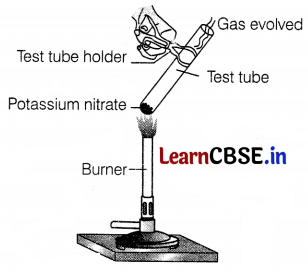
(a) Colourless
(b) Yellow
(c) Whitish grey
(d) Black
Answer:
(a) Colourless
When potassium nitrate is heated, then colourless gas is evolved, i.e. oxygen.

Question 2.
What principle should be considered when balancing chemical equations?
(a) Conservation of momentum
(b) Conservation of mass
(c) Conservation of energy
(d) Conservation of frequency
Answer:
(b) Conservation of mass
Explanation: The law of conservation of mass states that “mass can neither be created nor destroyed.” So, both sides of the chemical reactions have to be balanced to ensure that this law is followed and thus, the number of the reactant and the product molecules remains the same on both sides of the equation.
![]()
Question 3.
The graph given below represents the neutralization reaction. The pH of the solution changes as we add an excess base to an acid.
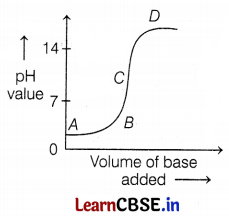
Which letter denotes the area of the graph where both base and salt are present?
(a) A
(b) B
(c) C
(d) D
Answer:
(d) D
The pH value of the base is above 7. So, in addition to the base, an acid neutralization reaction takes place.
Acid + Base → Salt + Water
In addition to the excess base, the pH of the solution rises above 7 due to the presence of base alongwith salt. Hence, D is the correct letter which represents both base and salt.
Question 4.
Which of the following is a function of pancreatic juice?
(a) Trypsin digests proteins and lipase digests carbohydrates.
(b) Trypsin digests emulsified fats and lipase digests proteins.
(c) Trypsin and lipase digest fats.
(d) Trypsin digests proteins and lipase digests emulsified fats.
Answer:
(d) Trypsin digests proteins and lipase digests emulsified fats.
Explanation: Pancreatic juice contains the digestive enzymes amylases, lipases, and trypsin, which are secreted by the pancreas. Amylase degrades starch, trypsin degrades proteins, and lipase degrades emulsified lipids.
Question 5.
Raj observed that after the reaction between hydrochloric acid and sodium hydroxide, sodium chloride and water are formed. Then, he searched for sodium chloride. Some of his statements about NaCl salt are given below.
I. It is also prepared by the chlor-alkali process.
II. It is a neutral salt, having a pH value = 7.
III. It is a white crystalline solid.
IV. It is also called rock salt.
Select the correct statement(s).
(a) I, II and IV
(b) II, III and IV
(c) II and III
(d) III and IV
Answer:
(b) II, III and IV
Among the given statements related to NaCI, only the (I) statement is wrong, because sodium hydroxide (NaOH) is prepared by the chlor-alkali process, but not NaCl salt.
Question 6.
An electric bulb is rated 220 V and 100 W. When it is operated at 110 V, the power consumed will be:
(a) 100 W
(b) 75W
(c) 50 W
(d) 25W
Answer:
(d) 25 W
Explanation:
We know that,
P= \(\frac{\mathrm{V}^2}{\mathrm{R}}\)
Where, P = Electric power
V = Potential difference in a circuit
R = Resistance
Now, R = \(\frac{\mathrm{V}^2}{\mathrm{P}}\)
R = \(\frac{220 \times 220}{100}\) = 484 Ω
As the voltage drop across the bulb is 110 V. The power consumed by the bulb is:
P
b
= \(\frac{\mathrm{V}^2}{\mathrm{R}}\)
= \(\frac{110 \times 110}{484}\)
P
b
= 25 W
Hence, the power consumed will be 25 W.
Question 7.
The bleaching powder gives the smell of chlorine due to
(a) formation of chlorine on exposure to the atmosphere
(b) instability of bleaching powder
(c) formation of excess of chlorine
(d) displacement reaction
Answer:
(a) formation of chlorine on exposure to the atmosphere
Bleaching powder (CaOCl
2
) reacts with carbon dioxide present in the atmosphere and produces calcium carbonate and chlorine gas, that’s why it gives the smell of chlorine.

![]()
Question 8.
Study the following diagram depicting the process of regeneration in a planarian flatworm. Which option correctly represents the different stages of regeneration shown in the diagram?

(a) A: New tissue formation and functional recovery, B: Initial injury, C: Blastema formation and cell division.
(b) A: Blastema formation and cell division, B: New tissue formation and functional recovery, C: Initial injury.
(c) A: Initial injury, B: Blastema formation and cell division, C: New tissue formation and functional recovery.
(d) A: Blastema formation and cell division, B: Initial injury, C: New tissue formation and functional recovery.
Answer:
(a) A: Initial injury, B: Blastema formation and cell division, C: New tissue formation and functional recovery.
Explanation: The correct sequence of stages shown in the diagram is:
(a) Initial injury: This is the stage where the flatworm is damaged or injured, leading to tissue loss or disruption.
True
True
Question 9.
Adrenaline hormone is secreted in the body during emergencies. What would be the effects of increased concentration of adrenaline on the body?
| Concentration of Glycogen in the Liver | Concentration of Glucose in the Blood | |
| (a) | Decrease | Increase |
| (b) | Increase | Increase |
| (c) | No Effect | Decrease |
| (d) | Increase | No Effect |
Answer:
(a) Concentration of Glycogen in the Liver – Decrease, Concentration of Glucose in the Blood – Increase
The concentration of glycogen in the liver will decrease. While the concentration of glucose in the blood will increase.
Question 10.
The equivalent resistance of a series combination of two resistances is X ohm. If the resistances are 10 Ω and 40 Ω respectively, the value of X will be:
(a) 10 Ω
(b) 20 Ω
(c) 50 Ω
(d) 40 Ω
Answer:
(c) 50 Ω
Explanation: We know that
Total Resistance
R = R
1
+ R
2
= 10 + 40
= 50 Ω
Hence, the value of X is 50 Ω.
Question 11.
What is the role of microvilli present in the small intestine?
(a) They help to move the food along
(b) They make a large surface area for absorption
(c) They protect against bacteria
(d) They move mucus over the surface
Answer:
(b) They make a large surface area for absorption
Microvilli increase the surface area for the absorption of products of digestion, i.e. amino acid, glucose, etc,
![]()
Question 12.
In Spirogyra, asexual reproduction takes place by:
(a) breaking up filaments into smaller bits.
(b) division of a cell into two cells.
(c) division of a cell into many cells.
(d) formation of young cells from older cells.
Answer:
(a) breaking up of filaments into smaller bits.
Explanation: In Spirogyra, asexual reproduction takes place by fragmentation, i.e., the organism simply breaks up into smaller pieces upon maturation. Each piece grows into a new individual without forming any gametes.
Question 13.
An electric fan runs from the 220V mains. The current flowing through it is 0.5A. How much energy is transformed in 2 min?
(a) 13200 J
(b) 110 J
(c) 1000 J
(d) 1500 J
Answer:
(a) 13200 J
Given, the potential difference, V = 220V
Current, I = 0.5 A
Time, t = 2 min = 120 s
Power, P =?
We know that,
Power (P) = VI
= 220 × 0.5
= 110 W
and E = Pt
= 110 × 120
= 13200 J
Question 14.
Dominant alleles are expressed exclusively in a heterozygote, while recessive traits are expressed only if the organism is ………………… for the recessive allele.
(a) Homozygous
(b) Heterozygous
(c) Normal
(d) None of these
Answer:
(a) Homozygous
Explanation: Mendel’s law of dominance states that in a heterozygote, one trait will conceal the presence of another trait for the same characteristic. Rather than both alleles contributing to a phenotype, the dominant allele will be expressed exclusively. The recessive allele will remain “latent,” but will be transmitted to offspring by the same manner in which the dominant allele is transmitted. The recessive trait will only be expressed by offspring that have two copies of this allele.
Question 15.
According to the law of dominance, which character expresses itself in the F1 generation?
(a) Dominant character
(b) Recessive character
(c) Hybrid character
(d) None of these
Answer:
(a) Dominant character
The dominant character expresses itself in the F
1
generation.
![]()
Question 16.
The Ratio of Number of Chromosomes in a Human Zygote and a Human Sperm is:
(a) 2 : 1
(b) 3 : 1
(c) 1 : 2
(d) 1 : 3
Answer:
(a) 2 : 1
Explanation: The number of chromosomes in human sperm is half the number of chromosomes in a zygote i.e., their ratio is 2 : 1.
Directions (Q. Nos. 17-20) Consist of two statements – Assertion (A) and Reason (R). Answer these questions by selecting the appropriate option given below.
(a) Both A and R are true and R is the correct explanation of A.
(b) Both A and R are true but R is not the correct explanation of A.
(c) A is true but R is false.
(d) A is false but R is true.
Question 17.
Assertion (A): Carbon reacts with oxygen to form carbon dioxide which is an acidic oxide.
Reason (R): Non-metals form acidic oxides.
Answer:
(a) Both (A) and (R) are true, but (R) is the correct explanation of (A).
Carbon is a non-metal form of acidic oxides, i.e. their aqueous solution turns blue litmus solution red.
Question 18.
Assertion: Mendel selected the pea plant for his experiments.
Reason: The pea plant is cross-pollinating and has unisexual flowers.
Answer:
(c) A is true but R is false.
Explanation: The flowers of pea plants are bisexual and they are self-pollinating, thus, self and cross¬pollination can easily be performed. They have a shorter life span and are the plants that are easier to maintain. Thus, Mendel chooses the pea plant.
Question 19.
Assertion (A): Mendel self-crossed F
1
progeny to obtain F
2
generation.
Reason (R): The F
1
progeny of a tall plant with round seeds and a dwarf plant with wrinkled seeds are all dwarf plants having wrinkled seeds.
Answer:
(c) A is true, but R is false.
The R can be corrected as The F
1
progeny of a tall plant with round seeds and a dwarf plant with wrinkled seeds are all tall plants with round seeds. This is because tallness and round shape are both dominant traits, while dwarfness and wrinkled shape of seeds are recessive traits.
Question 20.
Assertion: The XX chromosome gives rise to a female child whereas XY gives rise to the male child.
Reason: The Y chromosome in males is smaller than X chromosome.
Answer:
(b) Both A and R are true and R is not the correct explanation of A.
Explanation: The presence of an X chromosome is essential for the development of female characteristics, it is the presence or absence of the Y chromosome that primarily determines the development of male characteristics.
False
False
Section B
Questions No. 21 to 26 are Very Short Answer Questions.
Question 21.
An alkali metal A gives a compound B (molecular mass = 40) on reacting with water. The compound B gives a soluble compound C on treatment with aluminum oxide. Identify A, B, and C and give the reactions involved.
Answer:
Let, the atomic weight of alkali metal A be x.
When A reacts with water, it forms a compound B having molecular mass 40.
Let the reaction be
2A + 2H
2
O → 2AOH (B) + H
2
↑
According to the question,
x + 16 + 1 = 40 (Given)
∴ x = 40 – 17 = 23
23 is the atomic weight of Na (sodium). (1)
Therefore, the alkali metal (A) is Na and the reaction is

So, compound B is sodium hydroxide (NaOH).
Sodium hydroxide reacts with aluminium oxide (Al
2
O
3
) to give sodium aluminate (NaAlO
2
). Thus, C is sodium aluminate (NaAlO
2
). The reaction involved is

Question 22.
Differentiate between acids and bases.
Answer:
| Acids | Bases |
| 1. Acids are sour in taste. | Bases are bitter in taste. |
| 2. Acids turn blue litmus to red. | Bases turns red litmus to blue. |
| 3. An acid is a substance which gives H + ions in a water solution. | A base is a substance which gives OH – ions in a water solution. |
| 4. The orange colour of Methyl orange Indicator changes to red in acidic medium. | The orange colour of the Methyl Orange Indicator changes to yellow in bases. |
| 5. pH value of the acid is less than 7. | pH value of the base is greater than 7. |
|
6. When non-metallic oxides are dissolved in water, they form acids.
SO 3 + H 2 O → H 2 SO 4 |
When metallic oxides are dissolved in water they form bases.
CaO + H 2 O → CO(OH) 2 |
![]()
Question 23.
Why do all gametes formed in human females have X chromosomes?
Or
Suppose, normal maize has starchy seeds which remain smooth when dry. A mutant form has sugary seeds which go wrinkled when dry. When the mutant was crossed with a normal plant, an F
1
was produced which has smooth seeds. What would be the relative ratio of the different seed types, if the F1 was allowed to self-pollination?
Answer:
Human females have two ‘X’-chromosomes called sex-chromosomes. During meiosis, at the time of gamete formation, one X-chromosome enters each gamete. Hence, all the gametes possess an X chromosome. (2)
Or
Let the genotype of a normal plant with smooth seeds be SS and that of wrinkled seeds be ss. For a cross between SS and Ss, all the offspring produced will have genotypes (smooth seeds).
If the F
1
with smooth seeds Ss is allowed to self-crossed then maize plants with smooth and maize plants with wrinkled seeds will be formed in the ratio of 3 : 1. (1)
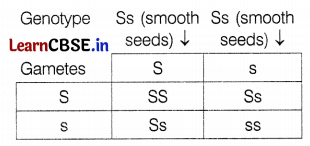
As it is evident from Punnett square, 3 plants with smooth seeds (SS, Ss) and 1 (ss) with wrinkled seeds are formed. (1)
Question 24.
State the post-fertilization changes that lead to fruit formation in plants.
OR
Answer the following questions:
(i) What is translocation? Why is it essential for plants?
(ii) Where do the substances in plants reach as a result of translocation?
Answer:
After fertilization, the zygote divides several times to form an embryo. The fertilized ovule forms a seed. The seed contains an embryo, enclosed in a protective covering, called the seed coat. As the seed grows further, other floral parts wither and fall off. This leads to the growth of the ovary, which enlarges and ripens to become a fruit with a thick wall called the pericarp.
OR
(i) The transport of food from leaves to other parts of the plant is called translocation. Translocation is essential for plants because without it food prepared by the leaves cannot reach other parts of the plant for their growth and development.
(iii) The substances in plants reach other tissues in plants from the leaves because of translocation.
Question 25.
Draw a ray diagram to show what happens after reflection to the incident ray when it is parallel to the principal axis and falling on a convex mirror.
Or
In an electrical circuit, two resistors of 2 Ω and 4 Ω are connected in series to a 6V battery. Find the heat dissipated by the 4 Ω resistor in 5 s.
Answer:
Appear to come from the focus of mirror after reflection.
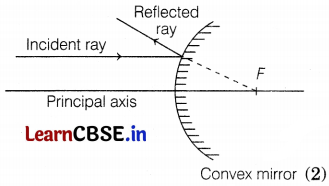
Or
Given, R
1
= 2 Ω, R
2
= 4 Ω, t = 5s, V = 6V
∴ Net resistance, R = R
1
+ R
2
= 2 Ω + 4Ω = 6 Ω
∴ Current, I = \(\frac{\mathrm{V}}{R}=\frac{6 \mathrm{~V}}{6 \Omega}\) = 1 A
In series, the same 1 A current passes through both resistors.
∴ Heat dissipated, H = I
2
R
1
× t
= (1)
2
× 4 × 5
= 20 J
Question 26.
Write the structural formulae of all the isomers of hexane.
Answer:

Section C
Questions No. 27 to 33 are Short Answer Questions.
Question 27.
An organic compound A is a constituent of many medicines and is used as an antifreeze and has the molecular formula C
2
H
6
O. Upon reaction with alk. KMnO
4
, the compound A is oxidized to another compound B with the formula C
2
H
4
O
2
. Identify the compounds A and B. Write the chemical equation for the reaction that leads to the formation of B.
Or
Name the compound formed when ethanol is heated more than concentrated sulphuric acid at 443K. Also, write the chemical equation of the reaction starting with the role of concentrated sulphuric acid in it. What would happen, if hydrogen is added to the product of this reaction in the presence of catalysts such as palladium or nickel?
Answer:
The organic compound A which is a constituent of many medicines and acts as antifreeze with the molecular formula C
2
H
6
O is ethanol (CH
3
CH
2
OH). Ethanol is oxidized to ethanoic acid (B) upon reaction with alk. KMnO
4
.

Or
When ethanol is heated more than concentrated sulphuric acid at 443K, ethene is formed. The reaction involved is

Conc. H
2
SO
4
acts as a dehydrating agent, it removes water molecules from a compound. If hydrogen is added to the product, i.e. ethene then ethane is formed.

![]()
Question 28.
Three resistors of 2 Ω, 3 Ω and 4 Ω are connected in (i) series, (ii) parallel. Find the equivalent resistance in each case.
Answer:
Given: R
1
= 2 Ω, R
2
= 3 Ω, R
3
= 4 Ω
(i) In series, the equivalent resistance is
R
s
= R
1
+ R
2
+ R
3
= 2 + 3 + 4
= 9 Ω
(ii) In parallel, if the equivalent resistance is R
p
, then
\(\frac{1}{\mathrm{R}_{\mathrm{p}}}=\frac{1}{\mathrm{R}_1}+\frac{1}{\mathrm{R}_2}+\frac{1}{\mathrm{R}_3}\)
or \(\frac{1}{\mathrm{R}_{\mathrm{p}}}=\frac{1}{2}+\frac{1}{3}+\frac{1}{4}=\frac{13}{12}\)
or R
p
= \(\frac{12}{13}\) = 0.92 Ω
Question 29.
Give three characteristics of a food chain.
Answer:
The characteristics of the food chain are as follows:
- It is always straight and proceeds in a progressive straight line. (1)
- It helps in understanding the food relationship and interactions among various organisms in an ecosystem. (1)
- It also helps us to understand the movement of toxic substances in an ecosystem and the problem of their biological magnification. (1)
Question 30.
What are the characteristics of energy transfer in the biosphere?
Answer:
The characteristics of energy transfer in biosphere are:
1. The ultimate source of energy is the Sun and is converted from one form to another.
2. Energy is continuously transferred the through food chain and energy flow is unidirectional.
3. There is a loss of some energy during transfer from one trophic level to the next.
4. Only 10% of energy is transferred from one trophic level to the next. The solar energy trapped by producers does not revert to the sun.
5. At each trophic level, some of the energy is utilized by organisms, the rest is lost to the environment and only 10% is available at the next trophic level.
Question 31.
(a) The following figure shows a ray of light travelling from medium A to medium B.
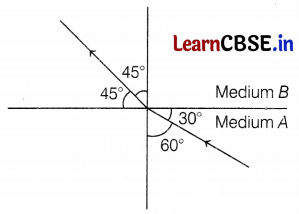
Determine the refractive index of medium B relative to medium A. From the given media, which one will be a denser medium?
(b) The speed of light in a transparent medium is 0.6 times that of its speed in a vacuum. What is the refractive index of the medium?
Answer:
(a) Given, the angle of incidence, i = 60°
The angle of refraction, r = 45°
The refractive index of the medium B relative to medium A,
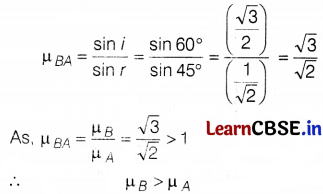
Hence, the medium B is the denser medium. (2)
(b) As, refractive index (n)
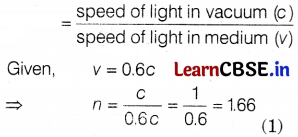
![]()
Question 32.
(i) State a law which determines the direction of the magnetic field around a current-carrying wire.
(ii) Name and state the law which is used to determine the direction of force on a current carrying conductor placed in a magnetic field?
(iii) State condition when the magnitude of force on a current-carrying conductor placed in a magnetic field is (a) zero (b) maximum.
Answer:
(i) Right-hand thumb rule which states that if we hold the current carrying conductor in our right hand such that the thumb points in the direction of flow of current, then the fingers encircle the wire in the direction of the magnetic field.
(ii) The direction of force on a current-carrying conductor placed in a magnetic field is obtained by Fleming’s left-hand rule.
This rule states that ” When forefinger, central finger and thumb of the left hand are stretched in such a way that they are mutually perpendicular to each other if the forefinger indicates the direction of the magnetic field, central finger indicates the direction of the current, then the thumb will indicate the direction of motion of the conductor i.e., the force on the conductor.
(iii) No force acts on a current-carrying conductor when the current in a conductor is parallel to the magnetic field.
The maximum force is exerted on the current-carrying conductor if it is perpendicular to the direction of the magnetic field.
Question 33.
Name the hormone secreted by the thyroid gland and describe its main functions.
Answer:
The thyroid gland is a bilobed structure situated at the posterior surface of the larynx. Its structure resembles ‘H’. Its weight in humans is about 25-30 g.
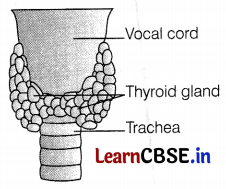
Functions of Thyroid Gland: (2)
- It mainly releases thyroxine or thyroid hormone which is a product of iodine. This hormone regulates metabolic activities in the body. (\(\frac{1}{2}\) + \(\frac{1}{2}\))
- It controls BMR rate, protein synthesis, increased heartbeat rate, and uses of glucose. (\(\frac{1}{2}\) + \(\frac{1}{2}\))
Section D
Questions No. 34 to 36 are Long Answer Questions.
Question 34.
(i) What happens when:
(a) Planaria gets cut into two pieces.
(b) A mature Spirogyra filament attains considerable length.
(c) On maturation sporangia bursts.
(ii) Students were asked to observe the permanent slides showing different stages of budding in yeast under the high power microscope.
(a) Which adjustment screw were you asked to move to focus the slides?
(b) Draw diagrams in the correct sequence to show budding in yeast.
(iii) What are the advantages of sexual reproduction over asexual reproduction?
OR
What is the placenta? Describe its structure. State its functions in the case of a pregnant human female.
Answer:
(i) (a) Each piece regenerates into a new Planaria.
(b) When a mature Spirogyra filament attains considerable length it breaks into two or more fragments and each fragment grows into a new individual.
(c) On maturation when sporangia bursts, spores are liberated, and they are dispersed. On getting a suitable substratum and under favourable conditions each spore germinates into new mycelium.
(ii) (a) Fine adjustment screws were moved to focus the slides.

(iii) The advantages of sexual reproduction over asexual reproduction are :
1. Variations are produced due to sexual reproduction which helps in better survival of offsprings in the changing environment.
2. More diversity is seen in the case of sexual reproduction as compared to asexual reproduction.
3. Due to recombination and crossing over in the meiosis process during the formation of gametes and as there is a mixing of male and female gametes, genetic variations are seen, which is the main cause of evolution.
OR
Placenta: It is the physical barrier connecting the embryo in the mother’s womb to the uterine wall to allow nutrient uptake, waste removal etc.
False
Functions: This provides a large surface area for glucose and oxygen to pass from the mother to the embryo, and the developing efnbryo will also generate waste substances which can be removed by transferring them into the mother’s blood through the placenta. Thus, it provides nourishment to the embryo, helps in excretion and provides immunity to the foetus.

Question 35.
(a) Mention secondary sexual characters in human males and females.
(b) Why are traits acquired during the lifetime of an individual not inherited?
Or
(a) Some glands produce chemical substances that change the activity of target organs. Name these substances. Also, gives the effect of the chemical produced by the adrenal gland pancreas.
(b) What is a reflex arc? How do muscle cells more?
Answer:
(a) Secondary sexual characters in males and females are as follows:
In Male,
- Hair growth on the face, chest, armpit (axillae), and over the pubis.
- The voice becomes deep and hoarse due to the growth of the larynx called Adam’s apple.
- The body becomes muscular.
In Female, in Female, in Female, in Female, in Female, in Female, in Female, in Female, in Female, in Female, in Female, in Female, in Female, in Female, in Female, in Female, in Female, in Female, in Female, in Female, in Female, in Female, in Female, in Female, in Female, in Female, in Female, in Female, in Female, in Female, in Female, in Female, in Female, in Female, in Female, in Female, in Female, in Female
- Growth of breasts and hair in axillae and over pubis.
- The Pelvis region becomes broad and the buttocks become heavy due to the deposition of fat.
- Development of accessory sex organs. (3)
(b) Acquired characters are structural, functional, and behavioral changes that an individual develops during their lifetime due to a particular environment, disease, trauma, use, and disuse, conditioned and unconditioned learning, etc. These traits are not passed to the DNA of germ cells and are lost with the death of an individual. Therefore, acquired traits like structural changes, and experience, cannot be transmitted to the progeny, i.e. these are not inherited. (2)
Or
(a) These substances are called hormones. The adrenal gland secretes adrenaline and prepares the body for a fight-or-flight response. e.g.lincreased heart rate and breathing. Dilation of the eyes. The pancreas secretes hormones that control the conversion of excess glucose to glycogen in the liver. Thus, maintains the concentration of glucose in the blood. (2)
(b) The pathway taken by nerve impulses in a reflex action is called the reflex arc. They allow rapid response, e.g. pulling of hand on touching a hot object. Muscle cells have special proteins that change their shape and arrangement in the cells in response to an electrical impulse. This forces the muscle cells to contract and relax, causing their movement. (3)
![]()
Question 36.
Myopia occurs when the eyeball becomes longer and the eye lens focuses light too close to the front of the eye. This happens because the distance between the lens and the retina increases. When the distance becomes more than the focal length of the lens, the eye lens cannot form a sharp image of the distant object on the retina but forms an image in front of it as shown in the figure.

If the focal length of the eye lens is short, it will form a sharp image of the distant object in front of the retina and not over it.

(i) Is the eye lens made of glass?
(ii) A myopic person uses specs of power – 0.2 D, what is the distance of the far point of his eye?
(iii) Which lens is used for correcting a myopic eye?
(a) Convex lens
(b) Concave lens
(c) Bifocal lens
(d) None of the above
(iv) The human eye forms the image of an object at its:
(a) Cornea
(b) Pupil
(c) Iris
(d) Retina
OR
Answer the following questions:
(i) What is persistence of vision?
(ii) Define the term angle of deviation.
(iii) Define the term power of accommodation. Write the modification in the curvature of the eye lens which enables us to see the nearby objects clearly?
Answer:
(i) No, the eye lens is not made of glass, it is made of fibrous jelly like material.
(ii) We know,
P = – 0.2 D
f = \(\frac{1}{P}=\frac{1}{-0.2}\) = -5 m
Distance of far point of his eye is 5 m.
(iii) (b) Concave lens: (i) (iii) (iv) (v) Concave lens: (v) Concave lens: (v) Concave lens: (v) Concave lens: (v) Concave lens: (v) Concave lens: (v) Concave lens: (v) Concave lens: (v) Concave lens: (v) Concave lens: (v) Concave lens:
(iv) (d) Retina
OR
(i) The image of any object formed on the retina persists for about 1/16 of a second. This continuance of sensation of an eye for some time even after the removal of the object is called persistence of vision.
: (i) The angle between the incident ray produced forward and the emergent ray produced backward is called the angle of deviation.
(iii) The ability of the eye lens to adjust its focal length, is called the power of accommodation. (iii) The ability of the eye lens to adjust its focal length, is called the power of accommodation.
Section E
Questions No. 37 to 39 are case-based/data-based questions with 2 to 3 short sub-parts. Internal choice is provided in one of these sub-parts.
Question 37.
Two students take test tubes separately with different solutions, copper sulphate, and iron sulphate solution. They immersed an iron nail in the first test tube and copper wire in the latter as shown in the figure. Observe the two test tubes A and B and answer the following questions.
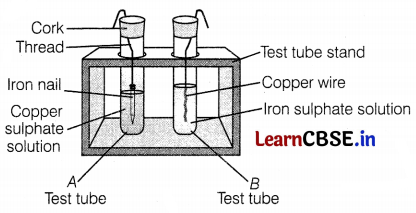
(a) Which type of reaction is involved in test tube A? Give its chemical equation.
(b) Draw your conclusion for test tube B.
Or
What will be the change in colour in test tube A?
Answer:
(a) In test tube A,

The reaction involved is a displacement reaction as copper is displaced by iron from its sulphate solution.
(b) As iron is more reactive than copper, copper will not displace iron from its sulphate solution; hence, there will be no reaction. (2)
Or
The copper sulphate solution is blue, but after the displacement reaction takes place, the ferrous sulphate solution forms which are light green. (2)
Question 38.
1. Take three iron nails and clean them by rubbing them with sand paper.
2. Take two test tubes marked (A) and (B). In each test tube, take about 10 mL of copper sulphate solution.
3. Tie two iron nails with a thread and immerse them carefully in the copper sulphate solution in test tube B for about 20 minutes.
4. Keep one iron nail aside for comparison.
5. After 20 minutes, take out the iron nails from the copper sulphate solution.
6. Compare the intensity of the blue colour of copper sulphate solutions in test tubes.

(a) What is shown in the above activity?
(b) The iron nail becomes brownish in colour and the blue colour of the copper sulphate solution fades? Why?
(c) Is the reaction possible? Give reason.
Cu(s) + ZnSO
4
(aq) → CuSO
4
(aq) + Zn(s)
OR
Give any two examples of a Displacement reaction.
Answer:
(a) The above activity shows Displacement reaction.
(b) The reason for this can be understood with the help of the following reaction,

In this reaction, iron has displaced or removed another element, copper, from the copper sulphate solution. Therefore, the iron nail becomes brownish in colour and the blue colour of copper sulphate solution fades.
(c) Zinc is more reactive element than copper. Therefore, copper cannot displace zinc from its solution. Hence, the given reaction is not possible.
OR

![]()
Question 39.
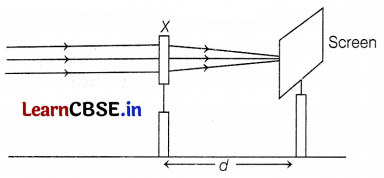
Prachi determined the focal length or device X by focusing a distant object on the screen as shown in the above diagram. The following table gives different positions of images and their sizes for different positions of objects in the case of image formation by lens.
| Position of Object | Position of Image | Relative Size of Image |
| At infinity | At focus F 2 | Highly diminished and point-sized |
| Beyond 2F 1 | Between F 2 and 2F 2 | Diminished |
| At 2F 1 | At 2F 2 | Same Size |
| Between F 1 and 2F 1 | Beyond 2F 2 | Enlarged |
| At focus F 1 | At infinity | Infinitely large or highly enlarged |
| Between focus F 1 and optical centre O | On the same size of the lens as the object | Enlarged |
Based on the diagram and table, answer the following questions.
(a) In the diagram, what is the device X and the distance d?
(b) What will be the nature of the image, if an object is placed at infinity?
(c) If the magnification of the converging lens is +1, then write the nature of the image.
Or
Calculate the focal length of a lens for an object placed 50 cm from the lens producing a virtual image at a distance of 10 cm in front of the lens.
Answer:
(a) When the parallel rays coming from a distant object (at infinity), pass through a convex lens, after refraction through the lens, the rays converge at focus on the other side of the lens. Hence, device X is the convex lens and distance d is its focal length. (1)
(b) When the object is at infinity, the nature of the image will be real and inverted. (1)
(c) As the magnification is positive, so the image formed will be virtual and erect.

The image formed is of the same size as that of the object. (2)
Or
Given, object distance, u = -50 cm
Image distance, v = -10 cm
Focal length, f =?
